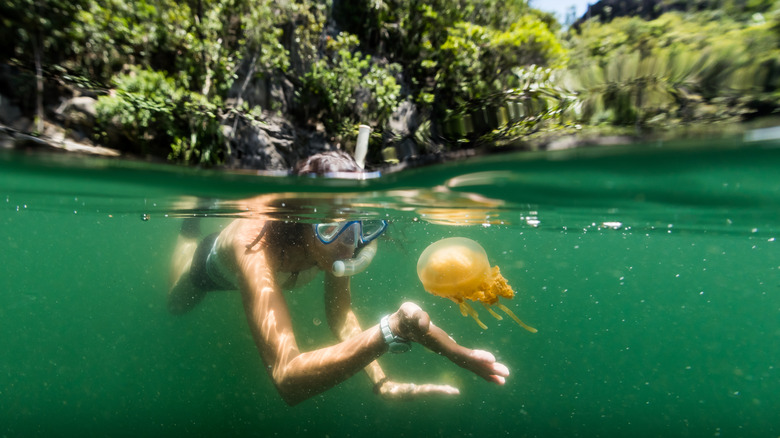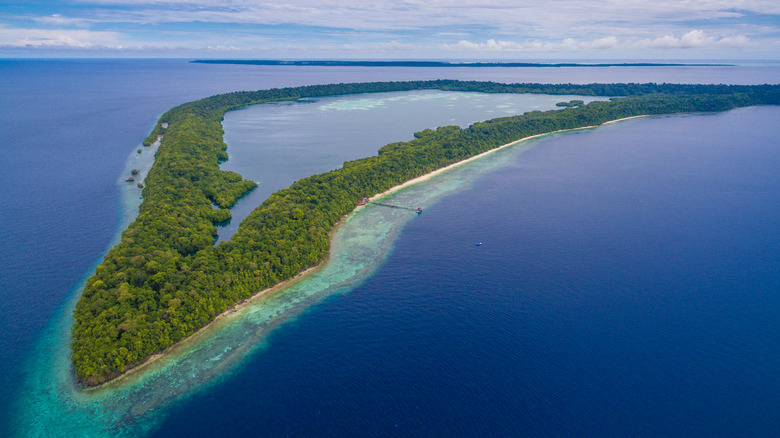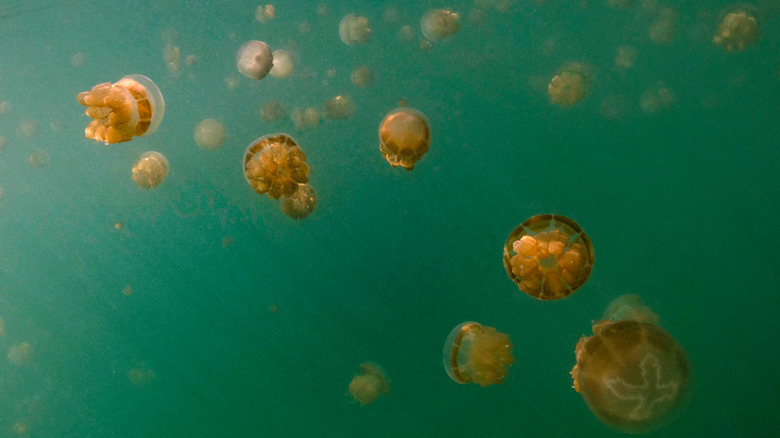One Of The Only Destinations To Swim With Stingless Jellyfish Is This Hidden Gem Island
We may receive a commission on purchases made from links.
Even among the bravest travelers, swimming with millions of jellyfish is not exactly inviting. While it would undoubtedly be a beautiful and memorable experience, it could also be a disaster waiting to happen. Yet in Kakaban Lake, Indonesia, off the coast of Borneo, the bloom of peaceful invertebrates is not your usual Scyphozoans — the scientific term for sea jellies. Though they do possess the hallmark bell-shaped body and strings of tentacles trailing behind, these animals evolved in a space without natural predators and no longer need a stinging defense.
Of the four species of jellyfish that inhabit this lake, the orange-spotted jellyfish have curiously ditched their spots. The Cassiopeia evolved to swim upside down, pointing its tentacles towards the sunlight. The moon jellyfish has a transparent saucer that grows up to a foot in diameter. The box jellyfish, universally feared as the most lethal, comes in a mini variety, taking up just one-third of its normal size with zero chance of delivering pain. If you've ever wanted to see jellyfish in their native habitat but keep your peace of mind, this is your chance.
What to expect at Kakaban Lake
Kakaban Lake is a brackish body of water, meaning it's part saltwater and part rainwater. It used to be connected to the Sulawesi Sea, allowing species to move freely between the lagoon and the ocean. But after geological uplift 11,000 years ago, the lagoon became sealed off at 130 feet above sea level. While some ocean water can still squeeze through underground fissures, the openings aren't large enough for most animal species. Over time, the four jellyfish species evolved into what they are today, sharing their habitat with crabs, sponges, sea cucumbers, sea snakes, and clams.
When you get off the boat at Kakaban Island, you'll walk past white sands through a dense jungle that hugs the lake (Kakaban means "hug" in the native tongue). In the center, you'll find the 92-acre lake with stingless jellies. It's surrounded by mangroves, save for a small pier. If it feels like you're worlds away from civilization, that's because you are. There are only two permanent residents on this Indonesian island; the rest are tourists, sometimes up to a few hundred per day.
Tips for visitors and how to get there
Kakaban Island is a government nature reserve with a few rules that travelers should know. While a wetsuit, snorkel, and booties are allowed, flippers and sunscreen are not, as the former could harm the fragile animals, and the latter's chemicals could leech into the water and damage the ecosystem. Travelers are also encouraged to enter the lake gently and swim around with care. Photography is permitted and encouraged; just be sure to bring a waterproof phone case. You'll need to pay an entrance fee of $2 in cash. Plan to spend a couple of hours exploring the lake so you can spot all four species of jellyfish and other marine critters.
Getting to the island is part of the adventure. First, you'll catch a flight to Berau near the coast. There are seven airports that serve this destination, including Jakarta, which costs $176 for a 2.5-hour flight on Batik Air. Once you arrive in Berau, take a two-hour boat ride to the Derawan Islands, an archipelago of uninhabited gems, including Kakaban. You can also hire a tour company like Scuba Junkies to take you on a tour of the lake and the surrounding islands, which offer world-class diving spots to observe rays, whale sharks, hammerheads, and barracudas. Kakaban does not have accommodation, but you'll be able to book a stay on the nearby island of Maratua. With no jellyfish stingers to ruin your trip, you're sure to sleep sound.


